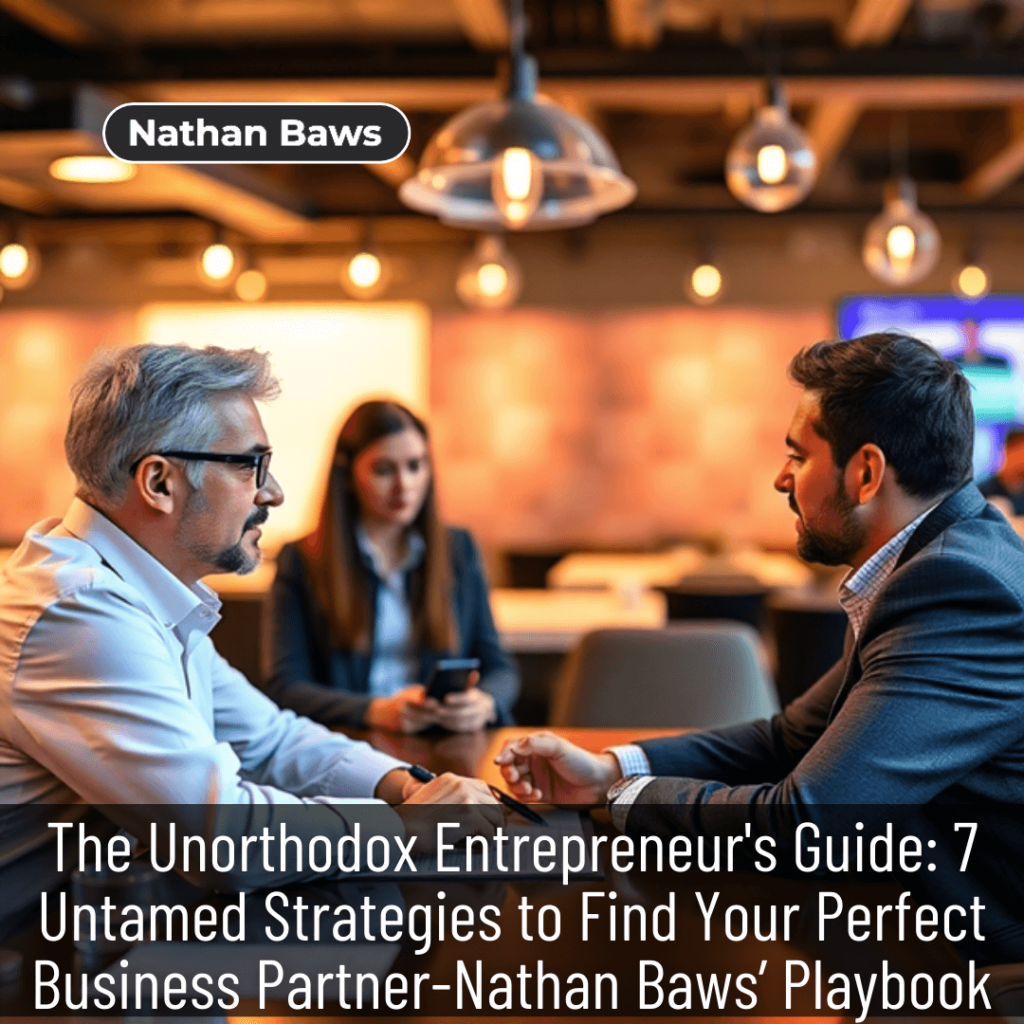Introduction
Hey there, I’m Nathan Baws, and let me tell you something straight up: in today’s cutthroat business game, blending in is a death sentence. You’ve got to stand out, make noise, and grab attention in ways that stick. Traditional marketing? It’s like whispering in a hurricane—good luck getting heard. That’s where guerrilla marketing ideas swoop in to save the day.
We’re talking clever, off-the-wall, budget-friendly moves that don’t just turn heads—they build real connections. I’ve been there, boots on the ground, building health shops from nothing, staring down sharks on Shark Tank, and turning setbacks into comebacks. Guerrilla marketing ideas have been my go-to, and in this deep dive, I’m spilling the unfiltered tricks, mindset shifts, and real-life wins that’ve fueled my ride and helped folks I’ve mentored. Let’s get into it.
Key Takeaways
- Unorthodox strategies that punch above their weight.
- Mindset tweaks to weather the entrepreneurial storm.
- Hands-on tips to scale your hustle on a shoestring.
- Stories of guerrilla marketing ideas making waves.
- How to unleash creativity to smash through obstacles.
The Mindset of a Guerrilla Marketer
Embracing the Unconventional
Guerrilla marketing ideas aren’t about toeing the line—they’re about kicking it over and blazing your own trail. You’ve got to ditch the playbook and think different. That’s how I’ve rolled my whole career. I didn’t climb some fancy ladder to where I am; I scrapped my way up with grit and a knack for seeing things sideways. Take my health shops—while others shelled out for glossy ads, I was out hosting free community workouts that got tongues wagging. Guerrilla marketing ideas thrive on flipping the script, spotting gold where others see dirt. It’s not just tactics; it’s a way of living the game.
Back when I was starting out, I’d walk into rooms full of suits and ties, and they’d look at me like I was nuts for skipping the usual routes. But that’s the point—guerrilla marketing ideas are about daring to be the odd one out. It’s worked for me, and it’ll work for you if you’re willing to step off the beaten path.
Risk-Taking and Resilience
Let’s be real: guerrilla marketing ideas mean taking chances. You’re tossing darts at a board you can’t fully see, and not every throw’s a bullseye. I’ve had my flops—like a promo that landed flatter than a pancake. But here’s the secret sauce: every miss sharpens your aim. My Shark Tank moment? No deal, but I walked out with lessons that money can’t buy—how to pivot, how to stand tall when the heat’s on. Resilience is the backbone of guerrilla marketing ideas. You fall, you learn, you get back up swinging.
I’ve mentored folks who froze after their first stumble. I tell ‘em what I’ve lived: risk is the ticket, and bouncing back is the payoff. You don’t win big playing it safe.
Creativity as a Competitive Advantage
In a world where everyone’s yelling for attention, creativity’s your megaphone. Guerrilla marketing ideas lean hard into that—finding ways to surprise, delight, and stick in people’s heads. When I kicked off my health shops, cash was tight, so I leaned on stunts like “healthiest snack” showdowns in local parks. No big ad spend, just pure imagination. It cut through the noise because it was fresh, fun, and real. Creativity’s been my edge, and it’s yours too if you tap into it.
I remember one time, a competitor laughed at my low-budget antics—until they saw the crowds piling in. That’s the power of guerrilla marketing ideas: they don’t need a fortune, just a spark.
The Power of Storytelling
People don’t latch onto products—they latch onto stories. Guerrilla marketing ideas hit home when you weave in your “why.” For me, it’s personal as can be. My own health struggles lit the fire to start my shops, and I don’t shy away from sharing that. It’s not about pushing supplements; it’s about connecting on a human level. When I speak or write at nathanbaws.com, I lean into those tales—they resonate. Your story’s your ace; play it loud and proud.
I’ve had customers tell me they stuck with my brand because they felt the heart behind it. That’s storytelling doing its job.
Guerrilla Marketing Ideas on a Budget
Leveraging Social Media
Social media’s a playground for guerrilla marketing ideas, and it’s dirt cheap. Forget stiff ads—I’ve run polls asking followers their favorite health hacks, posted raw clips of my shop setup, even tossed out goofy challenges like “tag a friend who needs a smoothie.” It’s me, unfiltered, and it builds a crew that cares. You don’t need a Hollywood budget—just a phone, some guts, and a willingness to engage. Guerrilla marketing ideas here are about real talk, not perfection.
One post I did—a quick vid of me mixing a crazy shake—went nuts online. Cost me five minutes and zero bucks. That’s the magic.
Community Engagement
Get out and shake hands. I’ve sponsored local runs, teamed up with gyms for free classes, and worked farmers’ markets like a pro. It’s not just about eyeballs—it’s about roots. People remember the brand that showed up, not the one hiding behind a logo. Guerrilla marketing ideas like these build loyalty that lasts. My shops grew because I wasn’t some distant name—I was the guy they knew.
Once, I set up a pop-up booth at a fair and handed out free samples. Next week, those folks were lining up at my door. Community’s everything.
Creative Content Marketing
Content’s your megaphone, and it doesn’t have to drain your wallet. I’ve written quick blogs on staying fit, shot videos spilling Shark Tank tales, and shared lessons from the grind. It’s about giving value—showing you know your stuff with a personal twist. Guerrilla marketing ideas shine when you’re the go-to voice, not just another sales pitch.
I had a post about “five health myths I busted” that folks kept sharing. Didn’t cost me a dime—just time and truth.
Public Relations and Media Outreach
PR’s a sleeper hit. I’ve pitched my story to local papers, landed radio gigs, and gotten ink just by being bold. Shark Tank gave me a leg up, no doubt, but even without it, a good yarn opens doors. Guerrilla marketing ideas here are about hustle—reach out, share your journey, and watch the spotlight find you.
One radio spot I did turned into a flood of new faces at my shop. All it took was a call and a pitch.

Scaling Your Startup with Guerrilla Marketing
Viral Marketing Campaigns
Viral’s the holy grail, and guerrilla marketing ideas can get you there. It’s about crafting something so cool, so funny, or so wild that folks can’t help but share. I ran a “healthiest snack” challenge—people posted their entries like crazy. It wasn’t random luck; it was built to spread. Guerrilla marketing ideas hit big when they’re sticky and sharable.
That campaign? It took off because it was fun and free to join. Simple, smart, viral.
Building Strategic Partnerships
Team up with the right folks, and you’re golden. I hooked my shops up with local fitness crews—cross-promos that brought in waves of new faces. Find partners who vibe with your mission and work together. Guerrilla marketing ideas get rocket fuel when you’re not solo. One collab I did doubled my reach overnight.
I swapped promo space with a gym once—cost us nothing, gained us everything. That’s partnership power.
Referral Programs
Turn your fans into your squad. Offer a perk—discounts, free stuff—for bringing buddies. I’ve done this with shop regulars, and it’s like free marketing on turbo. Guerrilla marketing ideas here are straightforward: reward the love, watch it multiply.
A “bring a friend” deal I ran turned one customer into three. Word-of-mouth’s the best ad.
Customer Loyalty Programs
Keep ‘em hooked. I’ve handed out punch cards, early product peeks, even thrown surprise thank-you parties for my loyal crew. Guerrilla marketing ideas spice this up—think exclusive events or random swag drops. It’s about making folks feel like VIPs, not just wallets.
One time, I gave my top buyers a sneak taste of a new line. They stuck around for years.
Guerrilla Marketing in the Digital Age
Interactive Content and Gamification
Make it a blast! I’ve run social quizzes—“What’s Your Health Style?”—and watched likes pile up. Guerrilla marketing ideas here are about play—toss in a prize or a leaderboard, and folks dive in. People love a challenge; hand ‘em one.
A fitness quiz I posted had people tagging friends for days. Fun’s the hook.
Influencer Marketing
Find voices that match your beat. I’ve teamed with local fitness buffs who’d plug my shops to their crew. Guerrilla marketing ideas amplify when someone trusted spreads the word. Go for fit, not just follower count.
One influencer shout-out packed my shop for a week. Right person, right message.
Personalized Marketing
Know your people inside out. I’ve sent tailored health tips to regulars based on their buys. Guerrilla marketing ideas get intimate—use what you know to make it feel personal, not mass-produced.
A custom thank-you note I sent? That guy’s still a customer five years later.
Mobile Marketing
Phones are king. I’ve used QR codes at events, texted deals to my list, even dropped location-based promos. Guerrilla marketing ideas on mobile are fast—hit ‘em where they live with something snappy.
A QR scavenger hunt I ran had folks buzzing—and buying. Mobile’s the future.
Measuring the Success of Guerrilla Marketing
Tracking Key Metrics
You’ve got to measure what matters. I track clicks, shop visits, whatever ties to my goal. Guerrilla marketing ideas need proof behind the hype—website hits, sign-ups, cash in the till. Pick your gauge and watch it.
One stunt I tracked showed triple the usual traffic. Numbers don’t lie.
Analyzing the Results
Dig into the aftermath. My snack challenge? Tons of shares, but I tweaked the next one for more leads. Guerrilla marketing ideas grow when you study what clicked and what clunked. Data’s your co-pilot.
I learned fast what fired up my crowd. Analysis is gold.
A/B Testing
Test two roads and pick the winner. I’ve pitted flyers against posts—doubled down on what worked. Guerrilla marketing ideas sharpen with this. Try, compare, perfect.
One A/B test showed posts beat paper hands-down. Tweak and triumph.
Gathering Feedback
Ask your people what’s up. Post-stunt, I’d chat with customers—did it land? Guerrilla marketing ideas thrive on real talk; their input keeps you grounded. Ear on, ego off.
Folks told me a pop-up rocked—they shaped the next one. Listen up.
Nathan Baws’ Guerrilla Marketing Playbook
Zero-Cost Marketing Stunts
I’m the guy who turns nothing into something. My shops blew up with stunts like pop-up fitness demos—zero cash, max impact. Guerrilla marketing ideas don’t need deep pockets; they need bold moves and a little swagger.
One free event packed my shop for a month. Cheap wins big.
Shark Tank Lessons
Shark Tank was a wild ride. No deal, but I walked away knowing how to pitch tight, nail my numbers, and sell the dream. Guerrilla marketing ideas need that core—flashy’s cool, but substance closes it. That stage was my crash course.
Those sharks grilled me, and I’m better for it. Tough love works.
Building Health Shops from Scratch
My shops? Pure hustle, no silver spoon. I started with a vision and guerrilla marketing ideas like community tie-ins—no big investors, just me and my grind. It’s proof you can build real with heart and smarts.
Day one, I was handing out samples myself. Boots-on-the-ground wins.
The Future of Guerrilla Marketing
This game’s always shifting. Tech’s opening wild doors—AR stunts, hyper-local mobile plays. I’m sniffing out what’s next at nathanbaws.com, always tinkering. Guerrilla marketing ideas will keep evolving; stay sharp or get left.
I’m eyeing AR for my next move. Future’s calling.
Conclusion
Guerrilla marketing ideas are your shot to rise above, connect deep, and grow fast—without a fat wallet. It’s about daring to be you, shaking off the flops, and letting creativity run the show. My path—from scrappy health shops to Shark Tank—proves it works. Take these plays, make ‘em yours, and go stir the pot.
Keen for more? Head over to Nathan Baws for top-notch consulting or a power-packed talk that’ll fire up your crew. Let’s turn your grind into gold.
FAQs
How do I cook up guerrilla marketing ideas?
Know your crowd, eyeball trends, think crazy. I wander, watch, brainstorm with my crew. Guerrilla marketing ideas spark when you ditch “normal” and dream big.
What’s a standout guerrilla marketing idea example?
Flash mobs, reverse graffiti, random drops—I’ve done snack challenges that lit up my town. Guerrilla marketing ideas win when they’re bold, fun, sharable.
How much do guerrilla marketing ideas cost?
Next to nothing if you’re clever. My stunts? Free or peanuts. Guerrilla marketing ideas thrive on hustle, not cash.
How do I size up guerrilla marketing ideas?
Track your wins—traffic, buzz, bucks. I ask folks too. Guerrilla marketing ideas need data and gut to shine.
Are guerrilla marketing ideas for all?
Pretty much—if you’ve got grit. My shops ate it up, but tweak to your tune. Guerrilla marketing ideas bend to fit.
What’s a guerrilla marketing idea no-no?
No aim, off-brand vibes, pushing too hard. I’ve dodged duds by staying true. Guerrilla marketing ideas need focus.
How do guerrilla marketing ideas mesh with my plan?
Weave ‘em in tight. My stunts boost my talks, consulting—total package. Guerrilla marketing ideas lift the whole game.
Keeping guerrilla marketing ideas clean and legal?
Stay safe, honest, above board. I check rules first. Guerrilla marketing ideas rock when they’re smart, not shady.
Building loyalty with guerrilla marketing ideas?
Surprise your tribe—perks, fun nods. I’ve thrown thank-you bashes for regulars. Guerrilla marketing ideas bond when they wow.
What’s guerrilla marketing ideas’ next wave?
Tech’s hot—AR, personal spins, social blasts. I’m plotting mobile tricks. Guerrilla marketing ideas evolve; keep up.
Table: Key Insights and Strategies
| Key Insight | Strategy | Example |
| Embrace Unconventional Thinking | Dare to be different. | Nathan Baws’ zero-cost stunts. |
| Risk-Taking and Resilience | Learn from flops, keep moving. | Nathan Baws’ Shark Tank lessons. |
| Creativity as an Edge | Connect with innovative ideas. | Nathan Baws’ health shop hustle. |
| Storytelling Builds Bonds | Share your real story. | Nathan Baws’ personal marketing tales. |
| Budget-Friendly Guerrilla Marketing | Use social, community, content smartly. | Viral social media campaigns. |
| Scale with Guerrilla Tactics | Go viral, partner up, reward referrals. | Dropbox’s referral program. |
| Digital Age Guerrilla Marketing | Try interactive, influencer, mobile plays. | Pokémon Go’s AR marketing. |
| Measure Your Wins | Track metrics, tweak what works. | Traffic, engagement, sales data. |


